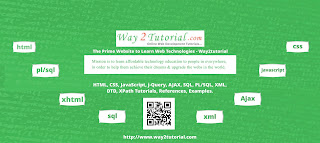HTML is an abbreviation of HyperText Markup Language. This language is
used to create website layouts. It is relatively easy to learn and execute the
code. HTML consists of a series of codes typed into text-file by the site
author- these are tags. The text is then saved as an HTML file and viewed as a
browser. This browser, like Internet Explorer, reads the file and translates the
text into a visible form. HTML is a useful tool for anyone who uses the
internet, and learning the basics may take you less time than you think.
Learning basics HTML: Open an HTML
document: To write up the HTML codes you can use text editors like Notepad,
Notepad++ and Textedit for Mac. Open a new document and use “File” and then
“Save as” in the top of the menu.
View your document with an internet browser: Once you save your blank
document, then find the document icon on your computer and double click on it.
Understand markup tags: Markup tags do not show up on a web page like
normal text, they tell your web browser how to display the page and its
content. Write end tags inside the angle bracket as well.
Write start tags in-between angle bracket <start tags >
Write end tags in-between angle bracket < end tags />
Write your first HTML tags: Every HTML document start with a <HTML>
Tag and end tag <end tags/>
Often, HTML files are started with a <!DOCTYPE html> line that
indicates that the file should be read as HTML
Remember to write everything else in this HTML5 Online Tutorial is between these two
tags.
Fill out the <head> portion of your document: In between <HTML>
</HTML> TAGS, write <head> </head> . In between head write
tite, write <title> </title>
Create body section: Everything else in the beginners will go in the body
<body> </body> . You should now have a document looks like this.
<html>
<head>
<title>How to Learn HTML - wikiHow</title>
</head>
<body>
</body>
</html>
Add text in various style: If you want to add creativity in the text then
you need to learn HTML attributes.
Formatting elements were designed to display special types of text:
<b> - Bold text
<strong> - Important text
<i> - Italic text
<em> - Emphasized text
<mark> - Marked text
<small> - Small text
<del> - Deleted text
<ins> - Inserted text
<sub> - Subscript text
<sup> - Superscript text
Divide text into paragraphs: If you try to write several lines of text in
your HTML document. <p>This is a separate paragraph.</p>
This sentence is followed by a line break.<br>before this sentence
begins.
Learn how to make list: Use the bullet: Use the HTML <ul> element to
define an unordered list
Use the CSS list-style-type property to define the list item marker
Use the HTML <ol> element to define an ordered list
Use the HTML type attribute to define the numbering type
Use the HTML <li> element to define a list item
Use the HTML <dl> element to define a description list
Use the HTML <dt> element to define the description term
Use the HTML <dd> element to describe the term in a description list
Spruce your page with horizontal, breaks and images: Now it’s time to add
things beyond the text.
Insert a Line in HTML: <br> or <hr>
Add images: <img src="your_image_url">
Links to other places on the page: To insert a link,
use the <a> tag with the href attribute to indicate the address of the
target page.
No comments:
Post a Comment